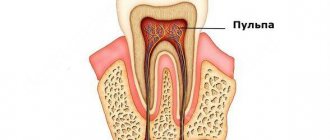Unfortunately, some patients do not want to have their teeth treated, which often leads to serious complications, including gumboil or periostitis. The person experiences severe pain, cannot eat, drink, or sleep, the cheek swells, and the temperature rises. In this case, you will need prompt assistance from a professional from the Center for Modern Dentistry, who will provide treatment without pain and stress using modern techniques and anesthetics. In our article we will talk in detail about the causes of tooth flux, why it is dangerous to health, as well as methods of treatment and prevention of caries and periodontitis.
What is tooth flux
Tooth gumboil is usually an exacerbation of diseases such as periodontitis or periodontitis. An acute inflammatory process begins in the area of the tooth root, when the nerve has already died and an infection develops in the root canal.
Periostitis is a common disease among children and adults. The inflammatory process manifests itself as follows: a cavity filled with pus appears on the mucous membrane of the jaw - a purulent bubble. As a rule, flux is accompanied by severe swelling of the cheek, pain and increased body temperature.
In the absence of professional dental care, the inflammatory process will develop further. Tooth flux can cause serious complications: phlegmon and sepsis. The patient will need a lot of time to recover.
Let's talk in more detail about the main types of fluxes.
Acute serous periostitis. As we wrote above, the inflammatory process occurs quickly and passes within a few days. It is characterized by severe swelling of the soft tissues. It is localized directly on the area with the diseased tooth, which is the main reason for the development of gumboil. The degree of inflammation depends on the structure of the vessels in the periosteum. The cause of the development of an acute form of serous flux can also be bruises and fractures. In this case, periostitis is called traumatic or post-traumatic. Most often it goes away on its own, but in some cases it can cause severe inflammation and the development of another type of flux - ossifying (fibrous growth).
Acute purulent periostitis. This type of gumboil is characterized by severe pain, which is often pulsating and spreads to the organs of vision and hearing, causing migraines. Pain is managed with medications and cold compresses. You should not heat the swelling site - this can lead to increased pain.
Purulent flux occurs with an increase in temperature to 37.5-38 degrees, the patient develops weakness and general malaise. It should be noted that the course of the disease depends on the location of the inflammation: in the lower jaw the process is more complicated.
The localization of inflammation depends on the location of the lesion:
- 1
Maxillary incisors - an inflammatory process on the upper lip and can spread to the nose. - 2
Maxillary canines and premolars - an inflammatory process in the periosteum.
- 3
Molars - an inflammatory process in the upper part of the cheeks.
- 4
Premolars - inflammation is localized in the lower part of the cheeks.
Chronic periostitis. The rarest form, which is usually localized in the periosteum of the lower jaw. In the chronic course of the disease, local inflammation is present, which does not change facial features. Characteristic symptoms are swelling in the mouth, enlargement of the periosteum, and lymph nodes. The development of this type of periostitis is a long process that takes from 4 to 8 months.
Symptoms of tooth flux
Among the first signs of periostitis are the formation of a painful infiltrate on the alveolar process, fluctuation, and swelling. The tooth itself usually doesn’t hurt anymore
If you discover symptoms of periostitis, we strongly recommend that you consult a doctor who will stop the spread of infection and remove inflammation. But if you haven’t decided or haven’t found the time to make an appointment with a dentist, then let’s figure out how the situation will develop further.
If the spread of infection is not stopped, then at the next stage the flux will manifest itself visually, as we wrote about earlier - a bubble appears on the gum, the cheek swells. In this case, urgently go to the Center for Modern Dentistry, otherwise you risk ending up in the hospital in a couple of days. Surgery will be complex and may last for a week or more.
FAQ:
How to remove a tooth abscess?
Obviously, it is worth contacting a qualified doctor who will help correct the situation. Usually, people turn to him when it already becomes a problem and in most cases, treating flux at this stage already requires surgical intervention - opening the abscess and draining the pus. Dentists at Dudko and Sons in Minsk perform this operation effectively and without pain. Treatment of gums is carried out with the help of antibiotics and antibacterial drugs prescribed by a doctor after examination and consultation.
How to rinse gumboil on a tooth to make it break out?
If your gums are swollen and your tooth hurts, we recommend that you rinse your mouth with various antiseptic and antimicrobial agents (for example, chlorhexidine). In addition to all this, you can rinse with sodium saline solution, sage infusions, and calendula tincture. The main thing to remember is that breaking through the gumboil does not mean curing it. Treatment of the causative tooth is necessary, otherwise after a while the cheek will swell again.
Diagnosis of tooth flux
At the dentist's appointment, a thorough examination of the oral cavity and an X-ray examination - a targeted or panoramic image - is carried out. In some cases, two studies will be required to make an objective diagnosis.
As soon as the diagnosis is made - exacerbation of chronic periodontitis and the diseased tooth is identified, the doctor begins treatment.
Causes of periostitis (flux)
- complication of caries;
- consequences of illiterate root canal treatment;
- as a complication after periodontitis;
- injuries of the maxillofacial area;
- hypothermia;
- inflammation of the gum pocket;
- complications after tooth extraction.
If you do not seek medical help in time, the infection from the subperiosteal region will spread to the bone and soft tissues, and serious surgical intervention will be required in a maxillofacial hospital. In addition, in advanced stages of periostitis, doctors resort to tooth extraction.
How is tooth flux treated?
If the cause of the inflammatory process is a diseased tooth, then at the first stage the question of the possibility of preserving it is resolved. Our experienced specialists will do everything to avoid removal.
Treatment usually involves five stages:
- first: the doctor, under local anesthesia, removes all tissues affected by caries, old fillings and creates direct access to the tooth canals
- second – removal of the nerve and determination of the length of the root canal
- third - expansion of the root canal of the tooth to gain access to its deeper areas
- fourth - installation of a paste containing calcium into the canal to stop acute inflammatory processes.
- fifth – temporary filling of the root canal
If necessary, an incision is made in the gum, the pus is removed and drainage is installed. For tooth flux in an adult, the doctor may also prescribe antibiotics or other drug therapy. In three to seven days you will need to come back for a follow-up appointment. If the doctor sees that there is no pus, the abscess is completely stopped, and the swelling of the cheek has subsided, he will seal the dental canal. The final stage of treatment will be the restoration of the crown of the tooth.
Is it necessary to remove a tooth during periostitis?
Previously, with an advanced form of the disease, a unit whose roots were damaged was torn out. Today doctors prefer conservative technologies. Removal is carried out only when the crown is completely destroyed and the quality of the roots is unsatisfactory.
If the image confirms that the root canals are not inflamed, prosthetics are performed. A tab is installed inside the root. It is held securely in place by dental cement. A crown made of metal, metal-ceramics, zirconium oxide or other material is fixed on top.
Tooth gumboil: what medications to take?
This is the most common question in Internet search engines when people try to deal with the problem on their own. Our answer: “Do not take anything before consulting a doctor!” Only the attending physician, taking into account the stage of the disease and your individual characteristics, can prescribe an antibiotic for tooth flux, which stops the inflammation process. The dentist will also advise which drug is best to use as an anesthetic.
Content:
- Gums gumboil - what is it?
- What causes gumboil to appear?
- Signs of dental flux
- How long does it take
- What to do in case of flux
- Is it necessary to remove a tooth during periostitis?
- Danger of violation
- Prevention
Almost everyone knows what flux is. The disease is quite common. Both children and adults encounter it. The tooth begins to hurt, as a convex lump appears at its base. Then a person has to look for ways to cure the disease.
There are many traditional ways to remove flux. However, it is unwise to use them. How to get rid of the problem, you need to find out from a qualified doctor. Otherwise, the disease may not be eliminated, but rather transformed into a chronic, sluggish form, which is very dangerous.
Prevention of flux in adults and children
Since the main cause of gumboil in both adults and children is complications of caries, careful oral care and timely dental treatment at the Center for Modern Dentistry are necessary. We recommend brushing your teeth morning and evening, rinsing your mouth after meals, and using dental floss and irrigator.
In addition, once every six months you need to come for a preventive examination at the dentist, where the doctor will identify caries and immediately begin treatment. An effective method for preventing diseases of the teeth and gums is a professional hygiene procedure in the dentist’s office, during which a specialist will remove hard dental plaque from the teeth, which is simply impossible to get rid of at home.
The Center for Modern Dentistry employs experienced specialists who use progressive techniques to treat tooth flux, as well as modern anesthetics that will relieve you of the pain of stress. Therefore, if you feel pain, do not delay your visit to the doctor, put off work and any other activities. Your health is much more important.
Diagnostic methods and treatment methods
An accurate diagnosis is a guarantee of successful treatment. To do this, the doctor conducts the necessary examination. It includes a diagnostic examination and fluoroscopy. To assess the degree of the inflammatory process, laboratory blood tests are performed.
There are two methods of flux treatment used in dentistry:
- Making an incision on the gum to open the purulent sac. After removing the pus, drainage is installed, which prevents premature healing.
- Cleaning an abscess through a root canal. This procedure is carried out when the cause of the flux is caries or the infection has penetrated through an existing crack in the tooth.
Special rinses are effective in treating flux. Solutions have regenerating and anti-inflammatory properties, therefore they can speed up healing. The simplest composition that can be used for rinsing with flux is a soda solution. If you carry out the procedure every couple of hours, you can quickly reduce pain and inflammation. To prepare the composition, dissolve a couple of teaspoons of soda in a glass of warm water. This amount of solution is enough for a day.
You can reduce swelling with a weak solution of manganese. This composition has strong disinfectant properties, which makes it possible to fight pathogenic microorganisms. For a similar effect, you can use the antiseptic agents Chlorhexedine or Miramistin. These drugs need to be used to irrigate the oral cavity.
An effective medicinal preparation for rinsing is Rotokan. It has a natural composition and contains extracts of chamomile, yarrow and calendula. For the solution, one spoon of the product is dissolved in a glass of warm water. Rinsing is carried out 4-5 times a day.
Is it possible to pierce flux with a needle at home?
» Other »
Question for experts: I have flux, what will happen if I pierce it with a needle?
Best regards, Yana
Best answers
Nothing will happen except that you will introduce an additional infection. This is a subperiosteal abscess, and the periosteum is very dense, you can’t just pierce it with a needle, and besides, it has a lot of pain receptors.
It’s not worth the risk, see a doctor, it will swell even more, don’t risk it.
Svetlana Vladimirovna Zherandoeva:
so what will happen? painful, fever, infection, jelly, pancakes.
You will either die from blood poisoning or pus will leak out of it, it will be fun for you. Or you’ll touch a nerve and then it’ll be even more fun for you. In any case, if you don’t want to go to the doctor, wait another day or two, sit on Ketanov, the flux will break through on its own...
and don't think about it!!!! There are specialists for this who will do it correctly and not so painfully
What kind of stupidity is it in the 21st century. Why are you a pussy?
Don’t even try, go to the dentist, he’ll do a great freeze and pull out the tooth (if the gumboil is from a diseased tooth), otherwise it may go along the roots of the neighboring teeth and you’ll end up with a complete paragraph. Run to the dentist!!!!
From my vast experience of problems with teeth, I still recommend going to the dentist. Because: 1. If you have gumboil (i.e. your tooth hurt all night), then trying to pierce it with a needle will lead to nothing. It will only hurt.2. If this flux has already turned into a fistula, then you can pierce it. A portion of pus will flow out. But since the cause of the infection has not been eliminated, it will form again and again.
So, it’s better to have five minutes of fear with a specialist!!!!
Why don’t you... bake the onion and put the petals on it... after a few more hours of laying it, it will ripen and all the nasty stuff will come out on its own.
I wouldn’t pierce it, although a friend of mine did it, and it ended without any consequences.
and I had gumboil a week later, a week later a white head appeared on the gumboil, I pressed with two fingers and squeezed out all the pus, then I wiped it with a cotton swab and cologne and now there is no flux and nothing bothers me)
Lol, just squeeze it out with your hand..(
-answer
This video will help you figure it out
Answers from experts
Take a piece of cotton wool, rub it and soak it in propolis tincture and place it between your cheek and lip overnight. By morning everything will be checked.
What, have you gone nuts?? ? which one to pierce? quickly see a doctor, they don’t joke about this, and they will put in a drainage, the gumboil is already suppuration, it needs to be cleaned. Amazing... TO THE DOCTOR!!!!
Absolutely not! Get sepsis (blood poisoning)! Only to the dentist!
Flux is the body's reaction to infection. After a few days, either 1. the pus itself comes out and the flux disappears, or 2. after a few days, the wing of the nose may swell, the temperature rises to 39 degrees. - further further infection.
Flux is cut only in dentistry. Under sterile conditions. Doing this yourself is life-threatening. Special knowledge in medicine is required... You are confusing flux and boil. The boil can be punctured. But also in sterile conditions. Go online and look...
That's a very difficult question…
It is possible, but NOT NECESSARY!!! LIFE THREATENING!
take a knife and pierce it and did it all yourself 100 times
I pierced it with a needle, a lot of pus came out with blood, then I took anti-inflammatory pills and it no longer bothers me for a year
If it is impossible to get to a dentist, you need to go to the emergency department. They either call an urgent (on-duty) dentist, or an emergency doctor provides assistance. And now about the most important thing. If indeed there is NO doctor.
Thoroughly rinse your mouth with lidocaine from the ampoule; if you don’t have it, take pieces of ice from the refrigerator and place them between your cheek and gum in the area of swelling for 2-4 minutes (a kind of “freezing”).
Then, under the control of a mirror, you pierce the “flux” with a sterile needle in several places and not deeply (3-5 mm), it is better to make a light, neat cut with a scalpel (sharp knife) in the area of greater tension. Outflow of pus. This is what I would have done in the absence of tools and medications. But for me this is a profession, and for you it’s the first time.
It is psychologically difficult, and there is no knowledge - you can create other complications (although if you go shallow, it is unlikely). Of course, it is far from death, but from phlegmon - ONE STEP. After diffuse phlegmon, the chances decrease sharply.
Be sure (again, only in the absence of a doctor) to take antibiotics and non-steroidal anti-inflammatory drugs to reduce complications. But, if you have a computer and Internet access, you don’t live in a remote village. Call an ambulance. This is their headache (the air ambulance is at their complete disposal - they need it, they will take it to Moscow).
See a doctor immediately! Such things are no joke!
Apply OLD lard to the gum.
In your situation, only an urgent trip to the doctor will save you; self-medication can only do harm.
urgently run to the doctor!!! If it bursts, there may be serious complications - sepsis, for example (blood poisoning). Abscess, phlegmon, and other various deadly nasty things are not a joke at all!!!
Definitely see a doctor! I delayed it for three days, then they slashed me from ear to ear... the gumboil spread to my throat... I spent a week in intensive care to see a doctor, don’t even think about waiting, they’ll pull out the tooth or at least see if it’s dangerous or not...
FOOL. (complain if you want, but you're a fool). If left untreated, pus can travel to the brain or mediastinum (heart). I don’t want to say what this entails, but maybe you can guess it yourself. At worst, your face will become distorted and you will walk around like a freak for a month. My friend’s neck was cut and she lost a tooth. Honey, go to the doctor, okay?
In general, it passes more often, but sometimes you have to slash your neck; in 20 years of work, several of them didn’t have time, it was too late, they died, the kingdom of heaven to them!! ! So think about it, just not for long
In this case, only an incision and drainage of pus will help. If you heat it, the flux will really “ripen”, the only question is which way it will burst - outward or into the bloodstream, and this is fraught with sepsis, penetration of pus into the meninges and other fatal troubles.
Only see a doctor! The scar on the neck is a reminder of this disease. And it’s good that it’s only a scar...
Source: https://dom-voprosov.ru/prochee/mozhno-li-protknut-flyus-igloj-doma
How to treat gumboil gums at home
It is impossible to cure odontogenic periostitis on your own. At home, you can only relieve pain and speed up the rehabilitation period after dental treatment.
For severe toothaches, the following will help:
What to rinse with?
Most often, hypertonic (soda-salt) baths and antiseptic rinses are prescribed. The former facilitate the release of pus and ichor from the wound, the latter disinfect the oral cavity and prevent the infection from spreading to neighboring tissues.
Rinsing does not have to be intense - just put the solution in your mouth and hold it on the “sick” side for 30 seconds. 4-5 mouth baths and rinses are enough per day.
Flux ointments
To completely eliminate the effects of flux after a gum incision, healing ointments and gels are used:
- Levomikol;
- Metrogil Denta;
- Holisal;
- Asepta (balm for gums);
- Stomatophyte;
- a mixture of streptocidal and ichthyol ointments.
Apply the medicine using a cotton swab.
Types of periostitis
Due to the occurrence:
- odontogenic (most common cause): due to dental diseases;
- traumatic;
- hematogenous: infection spreads through the blood;
- lymphogenous: the infection penetrates through the lymphatic vessels.
By localization:
- diffuse: affects many teeth;
- limited: within 1-2 teeth.
According to the type of disease:
- acute periostitis: pronounced symptoms, rapid course. It is divided into two forms: serous (the presence of transparent exudate in the tissues) and purulent - purulent exudate that can form an abscess. Sometimes purulent discharge enters the oral cavity through a fistula on the gum.
- chronic: quite rare, formed due to an untreated acute form.
Antibiotics
To eliminate the infection, doctors must prescribe antimicrobial therapy, without which the treatment of purulent processes would not be effective.
Standard antibiotic regimens are a combination of Metronidazole with Lincomycin or Clindamycin - drugs that kill gram-positive and anaerobic bacteria and protozoan microorganisms. The course is designed for ten days - 1500 mg of Metronidazole and 900 mg of Clindamycin (or 1500 mg of Lincomycin) per day. The daily dose is divided into 3 doses.
Modern dentistry abandons Lincomycin in favor of Clindamycin, since the first drug often causes allergic reactions, manifested in the form of intestinal disorders and rashes on the body. If Lincomycin cannot be replaced, it is better to take it not orally, but intramuscularly in the form of a 30% solution - 2 ml twice a day. Clindamycin can also be injected.
General spectrum antibiotics are effective in combating purulent inflammation:
- Amoxiclav;
- Flemoxin Solutab;
- Sumamed;
- Unidox Solutab;
- Tsifran St et al.
How can a dentist help if a patient has developed gumboil?
As a rule, advanced flux requires surgical dental intervention - that is, a dental surgeon opens the periosteum and gums and inserts a rubber tube there to remove the purulent contents. In this case, the tooth most often cannot be preserved for further restoration and is completely removed. To combat inflammation, the patient is prescribed antibiotics and antihistamines.
If the flux has just begun to develop, then perhaps there will be no need to cut the tissue - the doctor will simply open the tooth canals, treat them with an antiseptic and antibiotic, and the pus will come out on its own - in the few days that must pass before the next visit to VivaDent and filling the canals .
In any case, the decision about what treatment should be in a particular case - conservative or surgical - will be made by the dentist only after receiving x-rays of the tooth and the tissues around it.
What happens if periostitis is not treated?
It's simple. An increasing amount of pus will cause further development of swelling and puffiness of the face. Further, the lymph nodes located in the neck may become larger. Inflammation will also cause fever and pain.
A very dangerous complication of flux is phlegmon. This is a breakthrough of the “bag” in which the pus is located, and the free spreading of the contents over the muscles and tissues of the cheek, neck, etc.
Jaw osteomyelitis is another possible complication of untreated gumboil: it is an inflammation of the jaw bones (usually this occurs in the lower jaw).
In other words, it is better not to allow serious consequences, but to seek qualified medical help as soon as possible.











